Radiation Terms and Units
Scientists measure radiation in different ways. Sometimes, they measure the dose that a person receives from a radioactive source, and sometimes they measure the amount of radioactivity in water, or in soil, or in the air. These measurements are taken to determine if safety actions are needed.
There are different but interrelated units for measuring radioactivity and estimating health effects.
On this page:
Radioactivity
Radioactivity is the release of ionizing radiation that occurs when the nucleus of a radioactive atom decays. Activity refers to the frequency of radioactive decay (disintegrations per unit time) produced by a given amount of radioactive material. The ionizing radiation released can be in the form of alpha particles, beta particles, or gamma rays. The different forms of ionizing radiation have different potentials to damage human tissue. Learn more about different types of ionizing radiation here.
A material's radioactivity is measured in becquerels (Bq, international unit) and curies (Ci, U.S. unit). Because a curie is a large unit, radioactivity results are usually shown in picocuries (pCi). A picocurie is one trillionth of a curie. The higher the number, the more radiation released by the material.

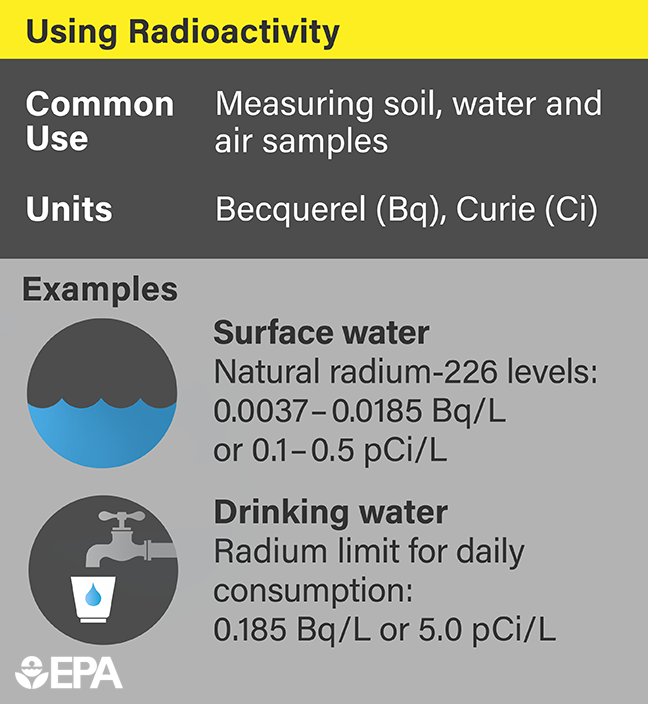
Examples:
- The natural radium-226 level of surface water generally ranges from 0.0037 to 0.0185 becquerels per liter (Bq/L), or 0.1 to 0.5 picocuries per liter (pCi/L).1
- The radium limit in drinking water for daily consumption is 0.185 becquerels per liter (Bq/L), or 5.0 picocuries per liter (pCi/L).2
Unit Conversions and Calculations
| Topic |
Becquerel (Bq) | International or SI unit |
Curie (Ci) | U.S. unit |
|---|---|---|
| How the unit is derived | Radioactivity represents the rate of radioactive decay. One becquerel (Bq) is equal to one radioactive decay per second. | One curie (Ci) is the approximate number of radioactive decays in one gram of radium per second – approximately 3.7 x 1010 decays per second. |
| Conversions | 1 becquerel (Bq) = 2.703×10−11 curie (Ci) | 1 curie (Ci) = 3.7 x 1010 becquerel (Bq) |
| Common Metric Prefixes |
1 gigabecquerel (GBq) = 1,000,000,000 Bq 1 megabecquerel (MBq) = 1,000,000 Bq 1 kilobecquerel (kBq) = 1,000 Bq |
1 millicurie (mCi) = 0.001 Ci 1 microcurie (µci) = 0.000 001 Ci 1 picocurie (pCi) = 0.000 000 000 001 Ci |
Absorbed Dose
Absorbed dose describes the amount of energy deposited per unit mass in an object or person. The units for absorbed dose are gray (Gy, international unit) and rad (rad, U.S. unit).
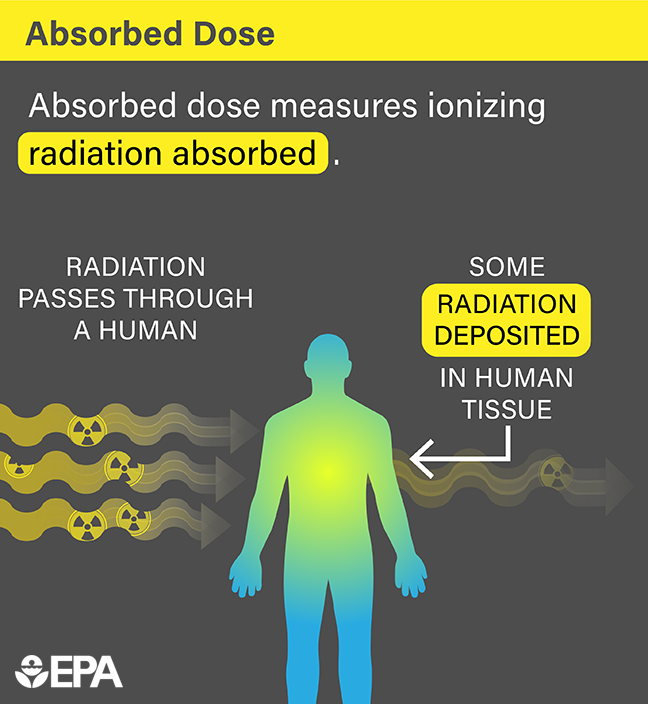
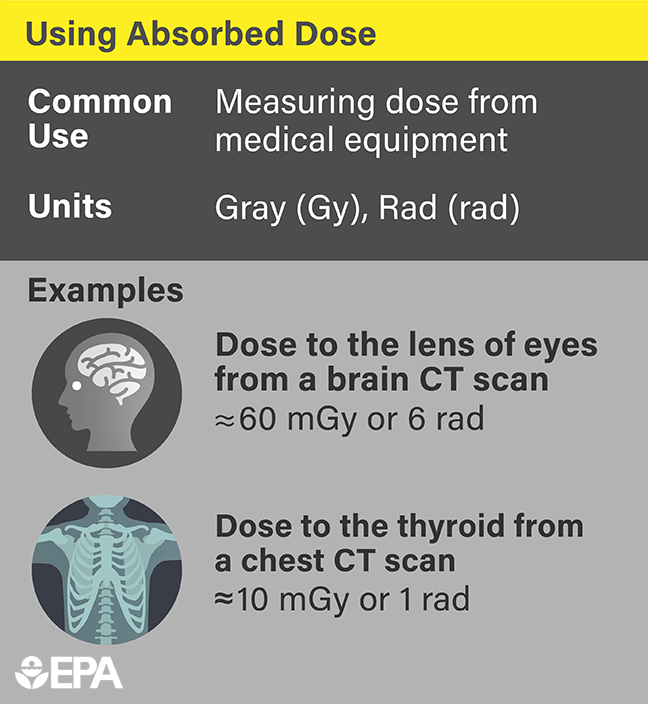
Examples:
- A dose to the lens of the eyes from a brain CT scan is about 60 milligray (mGy) or 6 rad.
- A dose to the thyroid from a chest CT scan is about 10 milligray (mGy) or 1 rad.3
Unit Conversions and Calculations
| Topic |
Gray (Gy) | International or SI unit |
Rad (rad) | U.S. unit |
|---|---|---|
| How the unit is derived |
Absorbed dose is energy per unit mass 1 gray (Gy) = 1 joule(J)/kilogram(kg) |
1 rad = 0.01 joule(J)/kilogram(kg) |
| Conversions | 1 gray (Gy) = 100 rad | 1 rad = 0.01 gray (Gy) |
| Common Metric Prefixes |
1 centigray (cGy) = 0.01 Gy 1 milligray (mGy) = 0.001 Gy |
1 millirad (mrad) = 0.001 rad 1 kilorad (krad) = 1,000 rad |
Effective Dose
Effective dose takes the absorbed dose (see above) and adjusts it for radiation type and relative organ sensitivity. The result is an indicator for the potential for long-term health effects (i.e., cancer and hereditary effects) from an exposure. It is used to set regulatory limits that protect against long-term health effects in a population. It also allows experts to compare anticipated health effects from different exposure situations. Because this value is a calculated approximation, not a physical quantity, it cannot be used to predict individual health effects. The units for effective dose are sievert (Sv, international unit) and rem (rem, U.S. unit).
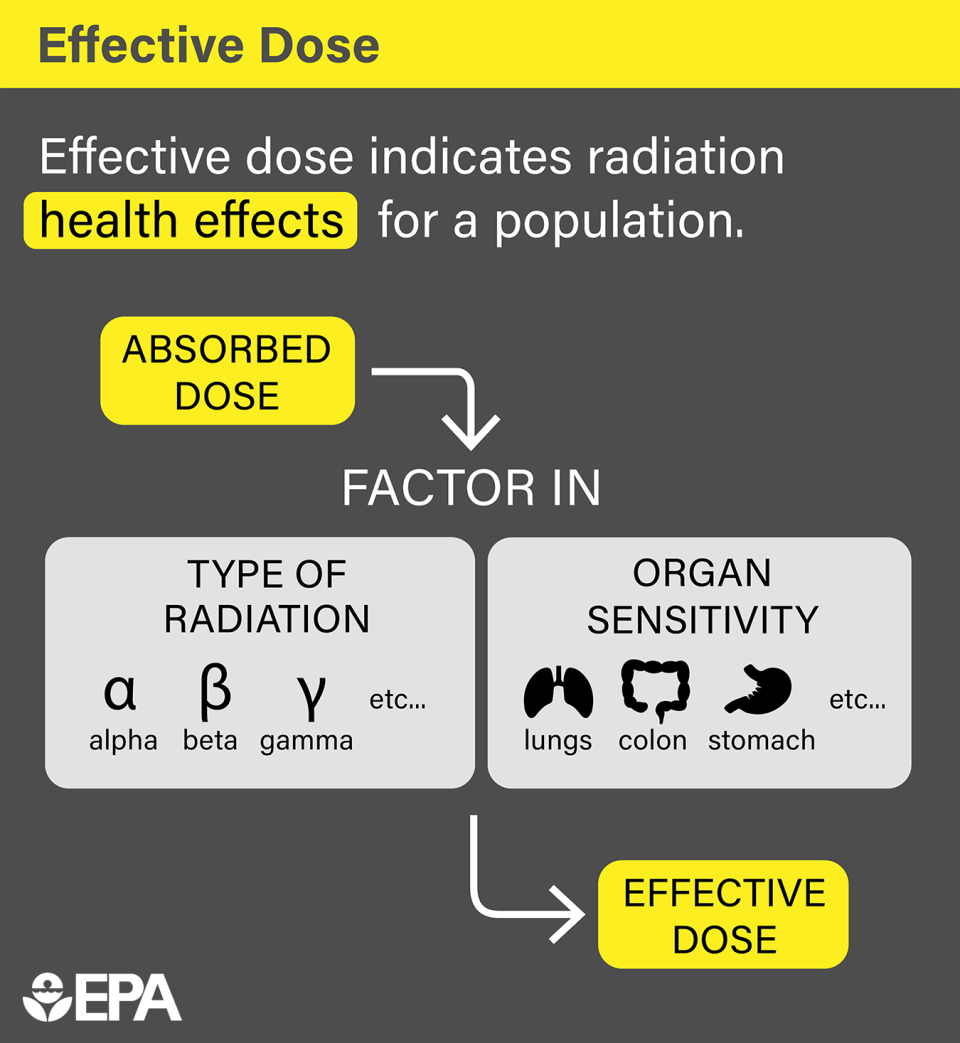
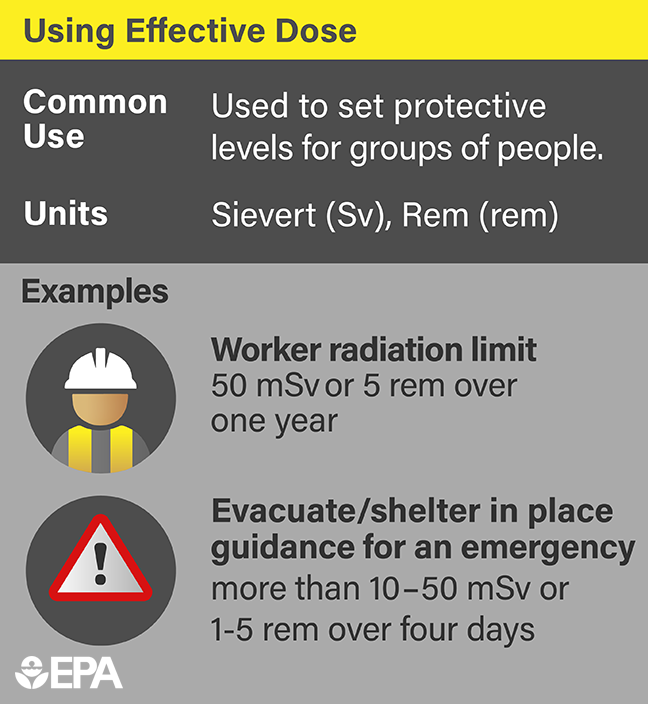
Examples:
- The annual radiation dose limit for workers is 0.05 sieverts (Sv) or 5 rem.4
- During an emergency, the guidance for when to evacuate or shelter in place is when the total projected dose exceeds 10-50 millisieverts (mSv) or 1-5 rem over the course of four days.5
Unit Conversions and Calculations
| Topic | Sievert (Sv) | International or SI unit | Rem (rem) | U.S. unit |
|---|---|---|
| Conversions | 1 sievert (Sv) = 100 rem | 1 rem = 0.01 sievert (Sv) |
| Common Metric Prefixes |
1 millisievert (mSv) = 0.001 Sv 1 microsievert (µSv) = 0.000 001 Sv |
1 millirem (mrem) = 0.001 rem 1 microrem (µrem) = 0.000 001 rem |
Use the Radiation Dose Calculator to estimate your yearly dose from sources of ionizing radiation.
View a PDF version of the Radiation Terms and Units infographic here.
1 Agency for Toxic Substances and Disease Registry, 1990. "Toxicological Profile for Radium" (p. 53). Retrieved from https://www.atsdr.cdc.gov/toxprofiles/tp144.pdf
2 Radionuclides Rule. Retrieved from https://www.epa.gov/dwreginfo/radionuclides-rule
3 Gao, Yiming et al., 2020. Patient-Specific Organ and Effective Dose Estimates in Adult Oncologic CT. American Journal of Roentgenology, 214:4, 738-746. Retrieved from https://www.ajronline.org/doi/full/10.2214/AJR.19.21197
4 United States Nuclear Regulatory Commission, 1991. "Regulations (10 CFR) Subpart C – Occupational Dose Limits." Retrieved from https://www.nrc.gov/reading-rm/doc-collections/cfr/part020/part020-1201.html
5 United States Environmental Protection Agency, 2017. "PAG Manual: Protective Action Guides and Planning Guidance for Radiological Incidents" (p. 50). Retrieved from https://www.epa.gov/system/files/documents/2025-04/epa_pag_manual_final_revisions_01-11-2017_cover_508-d.pdf
